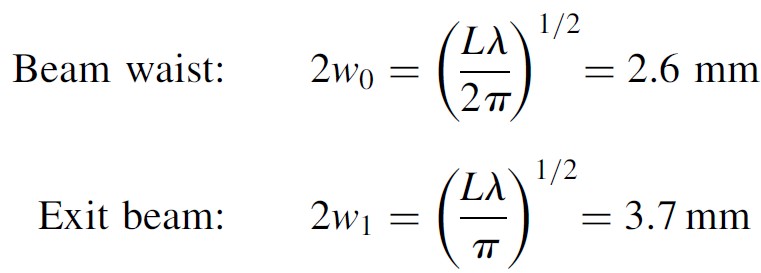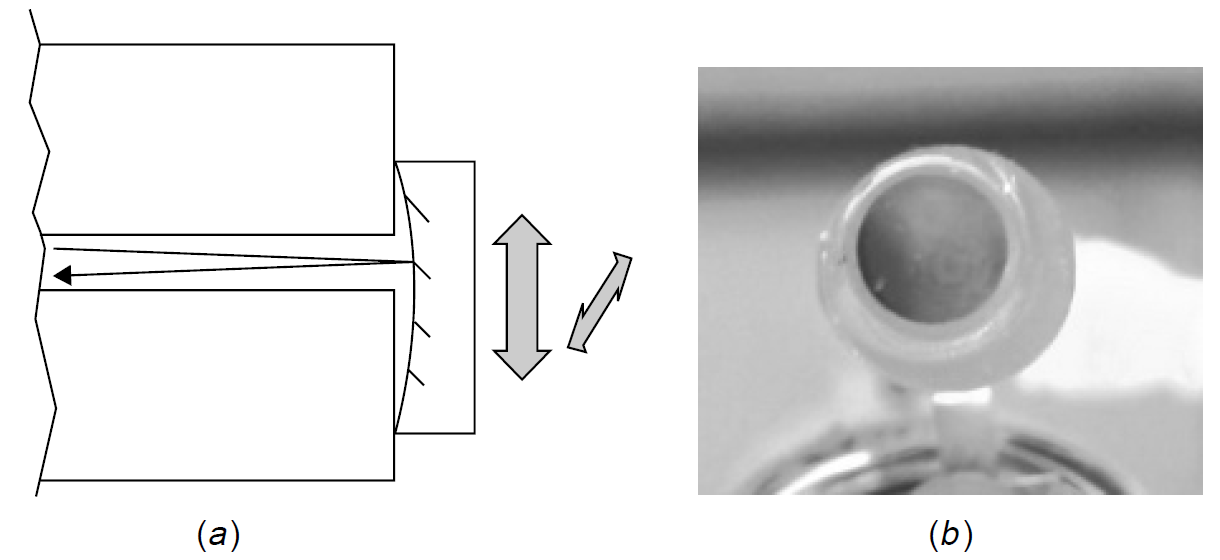


 الفيزياء الكلاسيكية
الفيزياء الكلاسيكية
 الكهربائية والمغناطيسية
الكهربائية والمغناطيسية
 علم البصريات
علم البصريات
 الفيزياء الحديثة
الفيزياء الحديثة
 النظرية النسبية
النظرية النسبية
 الفيزياء النووية
الفيزياء النووية
 فيزياء الحالة الصلبة
فيزياء الحالة الصلبة
 الليزر
الليزر
 علم الفلك
علم الفلك
 المجموعة الشمسية
المجموعة الشمسية
 الطاقة البديلة
الطاقة البديلة
 الفيزياء والعلوم الأخرى
الفيزياء والعلوم الأخرى
 مواضيع عامة في الفيزياء
مواضيع عامة في الفيزياء|
Read More
Date: 10-3-2016
Date: 2-2-2021
Date: 9-3-2016
|
COMMON CAVITY CONFIGURATIONS
Consider the case of a resonator with two plane mirrors (Figure 1.1a). Parameters g1 and g2 are both equal to unity (1), so the arrangement is stable although stability is marginal (i.e., the product of g1g2 is 1). In practical terms, marginally stable means extreme difficulty in alignment, and a cavity that can become misaligned very easily, usually resulting in the ceasing of lasing oscillation. For this reason, two plane mirrors are rarely used.
For any cavity resonator consisting of two spherical mirrors, the arrangement is stable within limits, as determined by the g parameters. A true confocal arrangement (Figure 1.1b) in which the radius of both mirrors is exactly equal to the separation between the mirrors (i.e., L) has g parameters equal to g1 = g2 = 0. The product of the g parameters is hence zero again, so this arrangement is stable. The confocal configuration yields the smallest average spot size of any stable resonator with the beam waist being w20= L(λ/2π) occurring at the center of the resonator and the largest spot size w21= L(λ/π) occurring at each mirror. This defines the diameter of the output beam if collimated (by a lens) at that point.

Figure 1.1. Common cavity configurations.
Other resonator configurations may have smaller spot sizes at one mirror or the other, as we shall see.
Example 1.1 Spot Sizes While a small spot size is desirable for many applications, confocal arrangements do not make efficient use of a large gain volume (such as in CO2 lasers, which frequently feature a large plasma tube bore). As an example, consider a CO2 laser with a 1-m-long tube. The spot size at the waist and at each mirror would be:

Considering that many CO2 lasers have plasma tube diameters of between 10 and 25 mm, it is easy to see how inefficient this cavity would be at utilizing the large amplifier volume. In contrast to this, consider a 30-cm-long HeNe in which the spot size at the mirrors would be 0.5 mm. This configuration is considerably more reasonable for a laser of this type since many HeNe tubes have plasma tubes with a diameter of 1 mm.
The confocal arrangement is extremely tolerant to misalignment of either mirror. A small angular tilt of either mirror still maintains the center of curvature of one mirror on the surface of the second cavity mirror, as shown in Figure 1.2. It is also forgiving of manufacturing tolerances in the radius of the cavity mirrors. Because of this feature, it is an excellent choice for a research laser, where frequent alignment may be required or where alignment cannot be performed by “rocking” or other means. Figure 1.1(c) is a concentric configuration in which the radius of each mirror is exactly L/2. It represents a confocal resonator, where the radius of curvature is reduced to its lowest limit. From the point of view of stability, this cavity is stable unless the radius of curvature of the mirrors is even slightly under L/2, in which case the arrangement becomes unstable (this may occur due to alignment or simply, manufacturing tolerances). This arrangement also suffers from difficulties in alignment since the focus of each mirror is coincident and hence difficult to align precisely.

Figure 1.2. Misalignment of a confocal cavity.
At the upper limit of the radius of curvature the mirrors become plane (and this arrangement is only marginally stable). However, in many practical lasers a variation of a confocal arrangement is used in which mirrors with radii just slightly over L (i.e., just longer than the cavity length) are employed. A cavity of this type features a larger waist diameter and hence better utilization of large tube bores. Compared to the true confocal arrangement, these cavities are more tedious to align and so, practically speaking, the radii of curvature are often designed to be only slightly greater (perhaps 5%) than the cavity length.
Other arrangements, such as Figure 1.1(d), use a combination of a long-radius spherical mirror (with the radius at least equal to and sometimes much longer than the cavity length) and a plane mirror. This arrangement is the most popular for low and medium power lasers such as HeNe and argon lasers. It is used in many commercial gas lasers (e.g., large-frame argons) where the OC is spherical and the HR plane allows the use of various optical configurations. While the OC stays in place, the rear optic may be changed to a wavelength selector for single-line use or a broadband reflector for multiline use.
If the radius of curvature is exactly L (the cavity length), the spot size at the plane mirror is minimal, since this is indeed the beam waist (but again this leads to stability problems similar to those with a true confocal cavity). The beam occupies a cone shaped volume inside the gain medium and so utilizes the amplifier volume more efficiently at one end than the other. In a small HeNe laser, the OC is often flat and is placed at the end of the tube away from the discharge. By placing the active gain medium (which in a small HeNe laser is the actual small capillary tube inside the larger laser tube) near the spherical mirror, the gain volume is used more effectively and higher powers are extracted from it, as shown in Figure 1.3.
An interesting feature of a spherical-plane cavity configuration is demonstrated in older HeNe tubes, which exploited this feature to assist in alignment of the cavity. During the 1970s and early 1980s, HeNe tubes were made entirely of glass, with mirrors affixed to the ground tube ends by epoxy (called a soft seal, this is no longer used in mass-produced HeNe tubes because such seals allow helium to diffuse through them slowly, and hence the resulting tubes had short lives). The use of a concave mirror allows alignment of the laser cavity using translation of the concave mirror alone; no angular adjustment was required. Figure 1.4 shows a concave mirror terminating the flat end of a laser which is not perfectly perpendicular to

Figure 1.3. Spherical-plane resonator for a HeNe laser.

Figure 1.4. Spherical reflector alignment on a HeNe tube.
the bore (indeed, it would be quite difficult to grind both glass tube ends perfectly parallel and perpendicular to the bore as would be required for lasing action). This technique of alignment, in which the edges of the mirror were in contact with the flat end of the glass tube, was a great boon to mass manufacturing of these tubes because it required only that the mirror be moved side to side and up/down until alignment was achieved, at which point the mirror was simply fixed in place with epoxy adhesive. Figure 1.4(b) shows one of these mirrors, which appears to be haphazardly affixed to the flat end of the glass tube. It is clearly not concentric with the tube bore, but this is exactly how alignment was achieved! The alternative, used on some early HeNe tubes, would be to have each mirror mounted on a three point mount allowing angular adjustment and attaching each mount to the tube using flexible metal tubing.
In the final resonator arrangement (Figure 1.1e), a concave and a convex mirror are used. Again, this arrangement is stable within the confines set out by the g-parameter equation. Concave–convex resonators can utilize much more of the lasing volume since the smallest spot size, at the focus of the concave mirror, is outside the cavity itself! These types of cavities are very sensitive to misalignment, though, so are rarely used in commercial lasers.
Not all lasers use stable resonators, and for certain high-power lasers such as excimer and carbon dioxide TEA lasers, unstable resonators are a popular option. Consider the two unstable resonator configurations depicted in Figure 1.5. Part (a), a positive branch confocal resonator, consists of a small convex and large concave mirror. The beam exits around the edges of the smaller mirror and has an annular shape. In part (b), a negative branch confocal resonator, the beam is also annular in shape. Because these resonators are not stable, light is not trapped

Figure 1.5. Unstable resonators.
in the cavity, at least for many round trips, so this arrangement is suitable only for use with high gain lasers, in which only a few transits through the gain medium are required to amplify the oscillations to a usable power level. The primary benefit of an unstable resonator is allowing the use of total reflectors that would not be damaged by high power levels (in the tens of kilowatts level) as a partially reflecting output coupler might be. The output beam does not pass through the output coupler itself as it does in a stable resonator configuration. In the case of large carbon dioxide lasers, solid metal mirrors (usually, copper with gold plating and often water cooled) may be used, which have very high damage thresholds.
Examining Figure 1.5, it is also evident that an unstable resonator utilizes a large volume of the lasing medium, allowing efficient extraction of energy. The biggest apparent problem with this configuration is that the shape of the beam is not Gaussian, so cannot be focused to a sharp point. In reality, it can be focused to almost as sharp a point (certainly better than many stable resonators yield when operating in high-order modes), so is quite suitable for materials-processing applications.
Finally, it may be worth noting that an OC can be avoided altogether in a stable cavity configuration by constructing a cavity in which one mirror has a hole in it. This approach, popular with amateur laser constructors for carbon dioxide lasers, usually utilizes a spherical-plane cavity for ease of alignment. A small hole with a diameter about 10% of the diameter of the plasma tube is drilled into the flat mirror and sealed with a window transparent to infrared radiation. In this manner, inexpensive metal film mirrors (usually, glass coated with copper or gold, both of which reflect infrared radiation well) may be used in place of an OC made of germanium or zinc selenide, which are comparatively expensive. The approach works but does not allow good mode performance and so is rarely used in commercial lasers.



|
|
|
|
علامات بسيطة في جسدك قد تنذر بمرض "قاتل"
|
|
|
|
|
|
|
أول صور ثلاثية الأبعاد للغدة الزعترية البشرية
|
|
|
|
|
|
|
مدرسة دار العلم.. صرح علميّ متميز في كربلاء لنشر علوم أهل البيت (عليهم السلام)
|
|
|